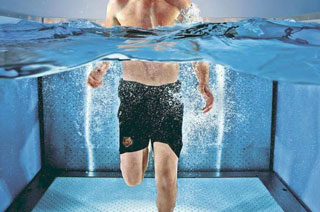These exercises will reduce osteoarthritis pain, symptoms

As one of the leading causes of pain and disability in Australia, osteoarthritis is no joke. But did you know that exercise is one of the most effective drug-free treatments for this debilitating condition?
That’s right, the widely held belief that exercise is harmful for those battling this degenerative joint disease is actually a myth. It’s never too late to get moving and the right kind of exercise can actually reduce pain, symptoms and the need for joint-replacement surgery.
As a disease of the entire joint, osteoarthritis can degrade the bone, cartilage, ligaments, fat and the tissues lining the joint – causing inflammation, pain, stiffness and loss of mobility.
While there is no cure, lifestyle changes such as losing weight and gentle ongoing exercise are highly effective at reducing pain, swelling and further damage, while ensuring ongoing mobility and quality of life. This, in turn, can cut the risk of falls and fractures by up to 30% in years to come.
Obviously, the right choice of exercise is key. Jogging is not recommended unless you are already well accustomed to it, because it can be traumatic on the joints and aggravate your condition. Instead, look for low-impact exercises that will build strength and aerobic fitness – such as aquatic exercises and walking.
As always, if you are unsure if an exercise is right for you, or if you’d like us to work with you on an osteoarthritis-appropriate management plan, please call our friendly team of Exercise Physiologists today.
Aquatic exercises
Aquatic exercises are gold for anyone with osteoarthritis, thanks to the water’s buoyancy relieving pressure on affected joints. And we’re not just talking swimming here, rather a range of exercises performed while standing in shoulder-height water, usually in a pool.
This is the ultimate in low-impact exercise, allowing you to build strength through light resistance without further impacting symptoms, especially with hip and knee osteoarthritis. And don’t be fooled. This kind of training gives you a challenging workout.
Walking
Walking is the best form of medicine and it’s perfect for all fitness and mobility levels. The best part is, you can start of slowly and gently, while increasing activity from day to day to build muscle strength, tone and endurance at your own pace.
Walking is easy on the joints, great for mental health and improves strength and circulation. Also, because it is an aerobic exercise, it strengthens the heart. And the best part is, walking is free … with a different route every day providing endless opportunities for fun.
Range-of-motion exercises
Range-of-motion exercises help improve joint function, with the name being a reference to how far you can move your joints in different directions. These exercises – usually recommended by a medical professional – help you move each joint through its full range of motion. These can include gentle stretching and movements that take your joints through their full span.
When done regularly, these exercises will keep your joints flexible, reduce pain, and improve balance and strength.
Aerobic exercise
This is a broad term for anything that gets your heart rate up while also exercising the lungs. Suitable aerobic exercises can include swimming, cycling, brisk walking if you can manage it, or time on an elliptical machine.
Aerobic exercise builds strength and stamina, while helping prevent weight gain from lack of mobility.
It’s great for the heart, lungs, mind and promotes good sleep patterns. It’s also a powerful way to stay socially connected with your community.
Strengthening exercises
These exercises help maintain and improve muscle strength, to prevent mobility issues and the risk of falling in future years. Strong muscles can support and protect joints that are affected by osteoarthritis. Resistance-band training is a good starting point for beginners, building up to weights when strength permits.
Consult with your medical professional
Mild to moderate exercise truly is the best medicine for osteoarthritis. However, every patient’s needs and disabilities are different, so a referral to a medical expert before starting any new program is recommended.
Here at Agility Rehabilitation, our team of accredited Exercise Physiologists are all university qualified with ongoing training to deliver the best, allied health service to you. We specialise in tailoring individual, exercise and rehabilitation programs for patients with chronic disabilities, injuries and health conditions.
Please call us on (08) 6162 8145 to discuss today. Rebates are available, in part or whole, for valid compensation claims, Medicare plans, DVA card holders or private health insurance holders. Contact us or your insurer to confirm if you are eligible for any rebates.